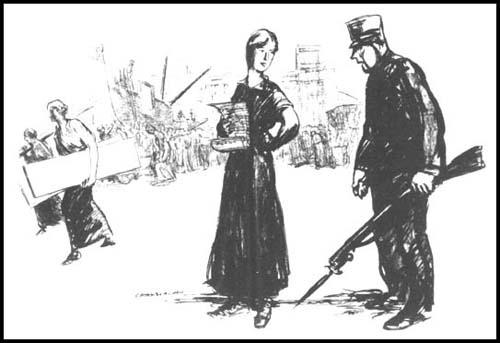Kenneth Chamberlain
Kenneth Chamberlain, the son of a small jeweler, was born in Des Moines, Iowa, in 1891. After graduating from high school in 1909 he attended Columbus Art School (1911-1913). Some of his drawings were published in Columbus Citizen and this encouraged him to move to New York where he secured work with American Art News.
While in New York City Chamberlain studied under Robert Henri where he met Maurice Becker and George Bellows. Both men were committed socialists and it was not long before Chamberlain shared these views: "I went to New York not even knowing what socialism was. I had some rough idea that it was dividing up the wealth. But when I got down with these fellows whose drawings and art I admired so greatly, why, if they'd been cannibals I probably would have turned cannibal."
Maurice Becker and George Bellows introduced Chamberlain to John Sloan, the art editor of The Masses and by 1913 the journal began publishing his cartoons. During the First World War he also began contributing to other papers such as the New York Evening Sun.

Man: The War's Over. You can go home now, and we'll run things.K. J. Chamberlain, The Masses (October, 1914)
Woman: You go put up that gun, and perhaps we'll let you help.
Although fellow radicals, such as Art Young and Robert Minor, who resigned from lucrative posts with leading newspapers when ordered to draw pro-war cartoons, Chamberlain willingly produced this type of material for the Philadelphia Evening Telegraph and Harper's Weekly. Chamberlain later explained: "I just went along after we were in the war. I wanted to hold my job as a cartoonist although I wasn't for the war."
After the Armistice Chamberlain worked for the Cleveland Press. He continued to contribute to radical journals such as The Liberator. This upset his editor at the newspaper who told him that "either you'll have to quit working for us or not sign your name." Chamberlain agreed to use the pseudonym, Russell and later described his actions as "an unhappy subterfuge" but was necessary in order to support his family.
In the 1920s Chamberlain worked for the New York Herald-Tribune. His last radical cartoon appeared in The Liberator in August 1923. He later admitted: "As you get older you lose that flash of youthful enthusiasm. I used to get so mad at some of the things I'd want to scream about it, but I wasn't the courageous type to go down and get beaten up by a cop... As you get older you lose that and you see both sides a little more."
In 1933 he went to work for Topics Publishing Company and as a result his cartoons appeared in 120 different newspapers. After losing his job in 1949 he worked for ten years for the National Association of Manufacturers.
Kenneth Chamberlain died in 1984.
Primary Sources
(1) K. R. Chamberlain, interviewed by Richard Fitzgerald (August, 1966)
I went to New York not even knowing what socialism was. I had some rough idea that it was dividing up the wealth. But when I got down with these fellows whose drawings and art I admired so greatly, why, if they'd been cannibals I probably would have turned cannibal. I was sympathetic for it, through having had this art start in Columbus from a disciple of those artists, and so I just fitted in what the Masses did. So I went right down there and sure enough they liked my work enough to use it. And my ideas came. I was won completely and sympathetic for it.
(2) K. R. Chamberlain quickly began disillusioned with the Russian Revolution (August, 1966)
When the Russian Revolution came along we thought that was the end of the struggle, that was the new hope for the world and everything. And I think Art Young never got over that hope. But Max Eastman was one of the first to become disillusioned. He went over there, and he could see that the dictatorship of the proletariat was just about as unpleasant as any other dictatorship.
(3) K. R. Chamberlain was a great fan of the cartoons produced by Art Young and Robert Minor.
There's something about Art Young's cartoons and Robert Minor's. They had a knack - I don't know, I can't describe it - but even though they were bitter they met it in sharp, they had a saving grace, either humour or an angle to it that you always liked.
(4) K. R. Chamberlain, interviewed by Richard Fitzgerald in August, 1966, explained why he changed from a radical cartoonist.
As you get older you lose that flash of youthful enthusiasm. I used to get so mad at some of the things I'd want to scream about it, but I wasn't the courageous type to go down and get beaten up by a cop. But nor would Eastman. He would skirt these things. He would organize meetings and speak, but he was never in any forefront of any struggle, physical violence. But as you get older you lose that and you see both sides a little more.
